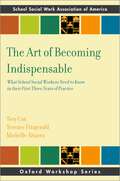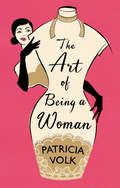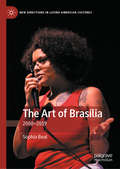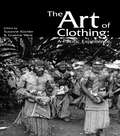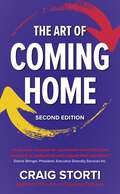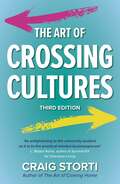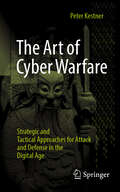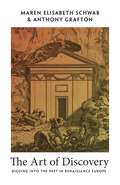- Table View
- List View
The Art of Asking Questions: Studies in Public Opinion, 3
by Stanley Le PayneWhile the statisticians are trying to knock a few tenths off the statistical error, says Mr. Payne, errors of tens of percents occur because of bad question wording. Mr. Payne's shrewd critique of the problems of asking questions reveals much about the nature of language and words, and a good deal about the public who must answer the poller's questions. For public opinion pollers, census takers, advertising copywriters, and survey makers of all kinds this book will be a tool for the achievement of more reliable results.Originally published in 1951.The Princeton Legacy Library uses the latest print-on-demand technology to again make available previously out-of-print books from the distinguished backlist of Princeton University Press. These editions preserve the original texts of these important books while presenting them in durable paperback and hardcover editions. The goal of the Princeton Legacy Library is to vastly increase access to the rich scholarly heritage found in the thousands of books published by Princeton University Press since its founding in 1905.
The Art of Becoming Indispensable: What School Social Workers Need to Know in Their First Three Years of Practice (SSWAA Workshop Series)
by Tory Cox, Terence Fitzgerald, and Michelle E. AlvarezDespite their institutional preparation and lived experiences, new school social workers encounter numerous practices, political considerations, community engagement strategies, and seemingly fundamental elements involved in the learning curve needed to move from entry-level to proficiency. The Art of Being Indispensable What School Social Workers Need to Know in Their First Three Years of Practice contains content specific to what they will need in their first three years of practice, bridging the learning gap from their academic preparation to early employment in P-12 settings. Organized into four sections - The Host Environment, The Macro School Social Worker, Integration and Intervention, and School Social Worker Sustainability - the content of the book is framed by a mixed-methods study on the needs of new practitioners. It is an indispensable guide that new school social workers can consult to effectively execute their roles and responsibilities.
The Art of Becoming Indispensable: What School Social Workers Need to Know in Their First Three Years of Practice (SSWAA Workshop Series)
Despite their institutional preparation and lived experiences, new school social workers encounter numerous practices, political considerations, community engagement strategies, and seemingly fundamental elements involved in the learning curve needed to move from entry-level to proficiency. The Art of Being Indispensable What School Social Workers Need to Know in Their First Three Years of Practice contains content specific to what they will need in their first three years of practice, bridging the learning gap from their academic preparation to early employment in P-12 settings. Organized into four sections - The Host Environment, The Macro School Social Worker, Integration and Intervention, and School Social Worker Sustainability - the content of the book is framed by a mixed-methods study on the needs of new practitioners. It is an indispensable guide that new school social workers can consult to effectively execute their roles and responsibilities.
The Art of Being a Woman: My Mother, Schiaparelli, and Me
by Patricia VolkPatricia Volk’s glittering memoir, written with charm, panache and wit, juxtaposes the lives of two women – the iconoclastic fashion designer Elsa Schiaparelli and the author’s own mother – to tell the story of how young Patricia fashioned herself into a woman.Patricia Volk’s mother Audrey was an upper-middle class New Yorker, a great beauty, a perfectionist, and a polished hostess who believed in women doing things the proper way. The iconoclastic Italian fashion designer, Elsa Schiaparelli, on the other hand, never found a rule she didn’t want to break. One of fashion’s most radical provocateurs, she was a cultural revolutionary who embodied the ‘daring’.For Patricia, who read Schiap’s 'scandalous' autobiography, Shocking Life, at a tender age, these two women offered fabulously contrasting lessons in everything from fashion, make-up, lingerie, family and entertaining, to love, sex, superstition and gambling – lessons that would stay with her for the rest of her life.Moving seamlessly between the Volks’ 1950s Manhattan home and Schiap’s astonishing life in New York, Rome and Paris (among pals like Dali, Duchamp, Picasso), The Art of Being a Woman weaves Audrey’s notions of female domesticity with Schiap’s groundbreaking creative vision to tell the witty, wise and utterly delightful story of how a young girl learned that there is more than one way to be a woman.
The Art of Bible Translation
by Robert AlterAn award-winning biblical translator reflects on the art of capturing the literary power of the Bible in EnglishIn this brief book, award-winning biblical translator and acclaimed literary critic Robert Alter offers a personal and passionate account of what he learned about the art of Bible translation over the two decades he spent completing his own English version of the Hebrew Bible.Alter’s literary training gave him the advantage of seeing that a translation of the Bible can convey the text’s meaning only by trying to capture the powerful and subtle literary style of the biblical Hebrew, something the modern English versions don’t do justice to. The Bible’s style, Alter writes, “is not some sort of aesthetic embellishment of the ‘message’ of Scripture but the vital medium through which the biblical vision of God, human nature, history, politics, society, and moral value is conveyed.” And, as the translators of the King James Version knew, the authority of the Bible is inseparable from its literary authority.For these reasons, the Bible can be brought to life in English only by re-creating its literary virtuosity, and Alter discusses the principal aspects of style in the Hebrew Bible that any translator should try to reproduce: word choice, syntax, word play and sound play, rhythm, and dialogue. In the process, he provides an illuminating and accessible introduction to biblical style that also offers insights about the art of translation far beyond the Bible.
The Art of Bible Translation
by Robert AlterAn award-winning biblical translator reflects on the art of capturing the literary power of the Bible in EnglishIn this brief book, award-winning biblical translator and acclaimed literary critic Robert Alter offers a personal and passionate account of what he learned about the art of Bible translation over the two decades he spent completing his own English version of the Hebrew Bible.Alter’s literary training gave him the advantage of seeing that a translation of the Bible can convey the text’s meaning only by trying to capture the powerful and subtle literary style of the biblical Hebrew, something the modern English versions don’t do justice to. The Bible’s style, Alter writes, “is not some sort of aesthetic embellishment of the ‘message’ of Scripture but the vital medium through which the biblical vision of God, human nature, history, politics, society, and moral value is conveyed.” And, as the translators of the King James Version knew, the authority of the Bible is inseparable from its literary authority.For these reasons, the Bible can be brought to life in English only by re-creating its literary virtuosity, and Alter discusses the principal aspects of style in the Hebrew Bible that any translator should try to reproduce: word choice, syntax, word play and sound play, rhythm, and dialogue. In the process, he provides an illuminating and accessible introduction to biblical style that also offers insights about the art of translation far beyond the Bible.
The Art of Bible Translation
by Robert AlterFrom the recipient of the National Jewish Book Award for Lifetime Achievement, a "hugely entertaining and irreverent" (Adam Gopnik, New Yorker) account of the art of translating the Hebrew Bible into EnglishIn this brief book, award-winning biblical translator and acclaimed literary critic Robert Alter offers a personal and passionate account of what he learned about the art of Bible translation over the two decades he spent completing his own English version of the Hebrew Bible.Alter’s literary training gave him the advantage of seeing that a translation of the Bible can convey the text’s meaning only by trying to capture the powerful and subtle literary style of the biblical Hebrew, something the modern English versions don’t do justice to. The Bible’s style, Alter writes, “is not some sort of aesthetic embellishment of the ‘message’ of Scripture but the vital medium through which the biblical vision of God, human nature, history, politics, society, and moral value is conveyed.” And, as the translators of the King James Version knew, the authority of the Bible is inseparable from its literary authority.For these reasons, the Bible can be brought to life in English only by re-creating its literary virtuosity, and Alter discusses the principal aspects of style in the Hebrew Bible that any translator should try to reproduce: word choice, syntax, word play and sound play, rhythm, and dialogue. In the process, he provides an illuminating and accessible introduction to biblical style that also offers insights about the art of translation far beyond the Bible.
The Art of Bible Translation
by Robert AlterFrom the recipient of the National Jewish Book Award for Lifetime Achievement, a "hugely entertaining and irreverent" (Adam Gopnik, New Yorker) account of the art of translating the Hebrew Bible into EnglishIn this brief book, award-winning biblical translator and acclaimed literary critic Robert Alter offers a personal and passionate account of what he learned about the art of Bible translation over the two decades he spent completing his own English version of the Hebrew Bible.Alter’s literary training gave him the advantage of seeing that a translation of the Bible can convey the text’s meaning only by trying to capture the powerful and subtle literary style of the biblical Hebrew, something the modern English versions don’t do justice to. The Bible’s style, Alter writes, “is not some sort of aesthetic embellishment of the ‘message’ of Scripture but the vital medium through which the biblical vision of God, human nature, history, politics, society, and moral value is conveyed.” And, as the translators of the King James Version knew, the authority of the Bible is inseparable from its literary authority.For these reasons, the Bible can be brought to life in English only by re-creating its literary virtuosity, and Alter discusses the principal aspects of style in the Hebrew Bible that any translator should try to reproduce: word choice, syntax, word play and sound play, rhythm, and dialogue. In the process, he provides an illuminating and accessible introduction to biblical style that also offers insights about the art of translation far beyond the Bible.
The Art of Brasília: 2000-2019 (New Directions in Latino American Cultures)
by Sophia BealPeople from outside of Brasília often dismiss Brazil’s capital as socially divided, boring, corrupt, and emotionally cold. Apparently its founders created not a vibrant capital, but a cultural wasteland. However, as Sophia Beal argues, Brasília’s contemporary artists are out to prove the skeptics wrong. These twenty-first-century artists are changing how people think about the city and animating its public spaces. They are recasting Brasília as a vibrant city of the arts in which cultural production affirms a creative right to the city. Various genres—prose, poetry, film, cultural journalism, music, photography, graffiti, street theater, and street dance—play a part. Brasília’s initial 1960s art was state-sanctioned, carried out mainly by privileged, white men. In contrast, the capital’s contemporary art is marked by its diversity, challenging norms about who has a voice within the Brasília art scene. This art demystifies the capital’s inequities and imagines alternative ways of inhabiting the city.
The Art of Building: International Ideas, Dutch Debate 1840-1900 (Routledge Revivals)
by Auke Van Der WoudThis title was first published in 2002: In the second half of the 18th century, philosophy provided the fundamental characteristics of architechture. The architects of the 19th century then introduced the empirical comparative study of buildings. This phenomenon has usually been regarded exclusively in terms of historicism, but this is to underestimate the fact that they were architects. The problems for which they sought solutions did not belong to the past, but were part of their own age or the future. The architecture of the past was, to the 19th-century architect, significant to a large degree as a silent witness of a bygone era - a representation of beauty. Historical architecture provided study material for their inquiries into the aesthetic "laws" that they hoped would give the 19th century a splendid contemporary architecture. The art of building, as a way of visibly edifying society, was the most important of all the arts, with architectural theory showing the way to this lofty purpose. This book takes this as a starting point. Focusing on place as well as time, the text discusses the Dutch architects who contributed to this idea, discussing several of the most important, but ultimately seeing their activities, not as the cause, but the expression of movements that continuously changed the face of architecture. The particularly "Dutch" nature of architecture took "visual beauty" to result from the visible success of technical intelligence and creativity rather than philosophy and aesthetics. The grand-19th century themes discussed in the book are, the author suggests, somewhat "un-Dutch", originating as they did from an idealist, intellectual tradition.
The Art of Building: International Ideas, Dutch Debate 1840-1900 (Routledge Revivals)
by Auke Van Der WoudThis title was first published in 2002: In the second half of the 18th century, philosophy provided the fundamental characteristics of architechture. The architects of the 19th century then introduced the empirical comparative study of buildings. This phenomenon has usually been regarded exclusively in terms of historicism, but this is to underestimate the fact that they were architects. The problems for which they sought solutions did not belong to the past, but were part of their own age or the future. The architecture of the past was, to the 19th-century architect, significant to a large degree as a silent witness of a bygone era - a representation of beauty. Historical architecture provided study material for their inquiries into the aesthetic "laws" that they hoped would give the 19th century a splendid contemporary architecture. The art of building, as a way of visibly edifying society, was the most important of all the arts, with architectural theory showing the way to this lofty purpose. This book takes this as a starting point. Focusing on place as well as time, the text discusses the Dutch architects who contributed to this idea, discussing several of the most important, but ultimately seeing their activities, not as the cause, but the expression of movements that continuously changed the face of architecture. The particularly "Dutch" nature of architecture took "visual beauty" to result from the visible success of technical intelligence and creativity rather than philosophy and aesthetics. The grand-19th century themes discussed in the book are, the author suggests, somewhat "un-Dutch", originating as they did from an idealist, intellectual tradition.
The Art Of Case Study Research (PDF)
by Robert E. StakeThis book presents a disciplined, qualitative exploration of case study methods by drawing from naturalistic, holistic, ethnographic, phenomenological and biographic research methods. Robert E. Stake uses and annotates an actual case study to answer such questions as: How is the case selected? How do you select the case which will maximize what can be learned? How can what is learned from one case be applied to another?
The Art of Chinese Poetry (Routledge Library Editions: Chinese Literature and Arts #1)
by James J.Y. LiuThis book, first published in 1962, is a majestic survey of the whole structure of Chinese poetry. It is a critical introduction to the field as well as an exposition of Chinese views on the nature of poetry. It discusses the Chinese language as a poetic medium from various angles – visual, semantic, auditory, grammatical and conceptual. It also describes the bases of Chinese versification and the major verse forms, and offers interpretations of various schools of traditional Chinese criticisms of poetry. The author suggests a synthesis among the different schools and evolves a view of poetry from which critical standards for Chinese poetry can be derived. In applying these standards, he attempts a further synthesis – one between this mainly traditional Chinese view of poetry and the modern Western method of verbal analysis. Imagery, symbolism, allusions and other features of Chinese poetry are analysed critically.
The Art of Chinese Poetry (Routledge Library Editions: Chinese Literature and Arts #1)
by James J.Y. LiuThis book, first published in 1962, is a majestic survey of the whole structure of Chinese poetry. It is a critical introduction to the field as well as an exposition of Chinese views on the nature of poetry. It discusses the Chinese language as a poetic medium from various angles – visual, semantic, auditory, grammatical and conceptual. It also describes the bases of Chinese versification and the major verse forms, and offers interpretations of various schools of traditional Chinese criticisms of poetry. The author suggests a synthesis among the different schools and evolves a view of poetry from which critical standards for Chinese poetry can be derived. In applying these standards, he attempts a further synthesis – one between this mainly traditional Chinese view of poetry and the modern Western method of verbal analysis. Imagery, symbolism, allusions and other features of Chinese poetry are analysed critically.
The Art of Civilization: A Bourgeois History
by Didier MaleuvreDidier Maleuvre argues that works of art in Western societies from Ancient Greece to the interconnected worlds of the Digital Age have served to rationalize and normalize an engagement with bourgeois civilization and the city. Maleuvre details that the history of art itself is the history civilization, giving rise to the particular aesthetics and critical attitudes of respective moments and movements in changing civilizations in a dialogical mode. Building a visual cultural account of shifting forms of culture, power, and subjectivity, Maleuvre illustrates how art gave a pattern and a language to the model of social authority rather than simply functioning as a reflective one. Through a broad cultural study of the relationship between humanity, art, and the culture of civilization, Maleuvre introduces a new set of paradigms that critique and affirm the relationship between humanity and art, arguing for it as an engine of social reproduction that transforms how culture is inhabited.
The Art of Clothing: A Pacific Experience
by Susanne Küchler Graeme WereThe Art of Clothing: A Pacific Experience is a collection of richly textured and tremendously engaging empirical studies of cloth and clothing in colonial and post-colonial Pacific contexts. By challenging readers to reconsider the very nature of the materiality of clothing, the editors productively situate this volume at the intersection of a number of ongoing interdisciplinary projects that are coalescing around an interest in cloth and clothing. The book as a whole speaks lucidly to issues of current concern in a wide range of academic fields - including cultural studies, material culture, Pacific history, art history, history of religions, and museum studies.
The Art of Clothing: A Pacific Experience
by Susan Kuchler Graeme WereThe Art of Clothing: A Pacific Experience is a collection of richly textured and tremendously engaging empirical studies of cloth and clothing in colonial and post-colonial Pacific contexts. By challenging readers to reconsider the very nature of the materiality of clothing, the editors productively situate this volume at the intersection of a number of ongoing interdisciplinary projects that are coalescing around an interest in cloth and clothing. The book as a whole speaks lucidly to issues of current concern in a wide range of academic fields - including cultural studies, material culture, Pacific history, art history, history of religions, and museum studies.
The Art of Coming Home
by Craig StortiIf you were lucky, you knew about and were prepared for culture shock when you moved overseas, But unless you are very lucky, you probably don't know about and are not prepared for reverse culture shock. And you should be. Most expats find coming home after an overseas assignment more difficult than adjusting to a foreign culture-and very few organizations and companies prepare people for the experience.Veteran trainer and consultant Craig Storti sketches the workplace challenges faced by returning businessmen and women as well as the re-entry issues of spouses, younger children, and teenagers. He also addresses in detail the special issues faced by exchange students, international development volunteers, and military and missionary personnel and their families.From leave-taking and the honeymoon stage through to reverse culture shock and eventual readjustment, The Art of Coming Home lays out the four stages of the re-entry process and details practical strategies for dealing with the challenges you will face each step of the way.Whether you're about to relocate abroad, are already living abroad, about to come home, or already home, this book walks you through the biggest adjustments, personal and professional, and in this new edition presents a complete do-it-yourself repatriation workshop to help you identify and address your individual readjustment issues.
The Art of Copying Art
by Penelope JacksonThis book is a study of the history, role and significance of copying art. Copies have enjoyed a different status from authentic artworks and though often acknowledged, very rarely have they been considered collectively as a genre in their own right. This volume showcases a variety of examples—from copies of famous artworks made and used as props in movies to those made innocently by student artists as part of their training. Examining the motivations for making copies, and reflecting on the reception of copies, is central to this book. Copies have historically filled voids in collections, where some sadly languish, and have become a curatorial burden. In other cases, having a copy assists in conservation projects and fills the place of a lost work. Ultimately by interrogating a copy’s role and intent we might ask ourselves if viewing a copy changes our experience and perception of an artwork.
The Art of Crossing Cultures
by Craig StortiAdjusting to a new culture and getting along with the local people can be a challenge for everyone who lives and works abroad. Whether in business, diplomacy, education, or as a long-term visitor, anyone can be blind-sided by a lack of international knowledge and experience and be caught at a disadvantage.In this completely revised and expanded third edition, Craig Storti outlines the personal challenges of adjusting to the change - anticipating differences, managing the temptation to withdraw, and gradually adjusting expectations of behaviour to fit reality - and shows what it takes to encounter a new culture head-on and succeed. Now an established bestseller, The Art of Crossing Cultures is a one-of-a-kind guidebook to bridging the cultural divide, incorporating an easy-to-understand model of cultural adjustment, and tips on how to master the process and develop adaptive strategies. This timely new edition focuses on how to deal with country and culture shock and includes many examples of cross-cultural misunderstandings. As well as revisions throughout, it includes a brand new chapter on crossing cultures at home."As enlightening to the university student as it is to the practical-minded businessperson." L. Robert Kohls, author of Survival Kit for Overseas Living
The Art of Cyber Warfare: Strategic and Tactical Approaches for Attack and Defense in the Digital Age
by Peter KestnerThe Art of Cyber Warfare explores the strategic and tactical approaches for offense and defense in the digital age. Drawing on historical conflicts from Sun Tzu to Carl von Clausewitz, the author illustrates that, despite changed conditions such as time, location, means, and resources – but not the laws of physics – it is possible to learn from past actions and reactions.The author aims to demonstrate in this book that, in reality, we have only transferred old methods into our current era but have forgotten to translate their reasons, effects, and the resulting lessons. For, as it has been for thousands of years, the reasons for human-created conflicts remain the same: wealth, fame, power, honor, or desire. Can we learn something from history for present and future (cyber) wars?
The Art of Danish Living: An illustrated guide to finding happiness in life and work from the bestselling author of The Little Book of Hygge
by Meik Wiking'A wonderful book' Chris Evans From the author of the million-copy bestseller, The Little Book of Hygge, comes a beautifully designed guide on how to get more out of work and live like the happiest people in the world: the Danish.We often look to the Danish lifestyle as a utopia: they enjoy long summer holidays and the cosiest, hyggelig winters, but their happiness isn’t just limited to their free time. Almost two thirds report high job satisfaction, and 58% say they would continue working even if they won the lottery. But what exactly are the ingredients of happiness at work? And how can we live more like that?Meik Wiking, the world’s favourite happiness expert, is back with more of his wise yet simple snippets of inspiration from Danish culture, and shows us that nurturing a sense of purpose, trust between you and your manager and freedom within your role can mean more than any job title. Based on stats from his own research and designed with his trademark style, this book is sure to improve your happiness levels.We will spend around a third of our lives at work, so why not feel happier while we do it?'Such a lovely book' Ranvir Singh, on Lorraine
The Art of Discovery: Digging into the Past in Renaissance Europe
by Maren Elisabeth Schwab Anthony GraftonA panoramic history of the antiquarians whose discoveries transformed Renaissance culture and gave rise to new forms of art and knowledgeIn the early fifteenth century, a casket containing the remains of the Roman historian Livy was unearthed at a Benedictine abbey in Padua. The find was greeted with the same enthusiasm as the bones of a Christian saint, and established a pattern that antiquarians would follow for centuries to come. The Art of Discovery tells the stories of the Renaissance antiquarians who turned material remains of the ancient world into sources for scholars and artists, inspirations for palaces and churches, and objects of pilgrimage and devotion.Maren Elisabeth Schwab and Anthony Grafton bring to life some of the most spectacular finds of the age, such as Nero’s Golden House and the wooden placard that was supposedly nailed to the True Cross. They take readers into basements, caves, and cisterns, explaining how digs were undertaken and shedding light on the methods antiquarians—and the alchemists and craftspeople they consulted—used to interpret them. What emerges is not an origin story for modern archaeology or art history but rather an account of how early modern artisanal skills and technical expertise were used to create new knowledge about the past and inspire new forms of art, scholarship, and devotion in the present.The Art of Discovery challenges the notion that Renaissance antiquarianism was strictly a secular enterprise, revealing how the rediscovery of Christian relics and the bones of martyrs helped give rise to highly interdisciplinary ways of examining and authenticating objects of all kinds.
The Art of Discovery: Digging into the Past in Renaissance Europe
by Maren Elisabeth Schwab Anthony GraftonA panoramic history of the antiquarians whose discoveries transformed Renaissance culture and gave rise to new forms of art and knowledgeIn the early fifteenth century, a casket containing the remains of the Roman historian Livy was unearthed at a Benedictine abbey in Padua. The find was greeted with the same enthusiasm as the bones of a Christian saint, and established a pattern that antiquarians would follow for centuries to come. The Art of Discovery tells the stories of the Renaissance antiquarians who turned material remains of the ancient world into sources for scholars and artists, inspirations for palaces and churches, and objects of pilgrimage and devotion.Maren Elisabeth Schwab and Anthony Grafton bring to life some of the most spectacular finds of the age, such as Nero’s Golden House and the wooden placard that was supposedly nailed to the True Cross. They take readers into basements, caves, and cisterns, explaining how digs were undertaken and shedding light on the methods antiquarians—and the alchemists and craftspeople they consulted—used to interpret them. What emerges is not an origin story for modern archaeology or art history but rather an account of how early modern artisanal skills and technical expertise were used to create new knowledge about the past and inspire new forms of art, scholarship, and devotion in the present.The Art of Discovery challenges the notion that Renaissance antiquarianism was strictly a secular enterprise, revealing how the rediscovery of Christian relics and the bones of martyrs helped give rise to highly interdisciplinary ways of examining and authenticating objects of all kinds.
The Art of Doing Business Across Cultures: 10 Countries, 50 Mistakes, and 5 Steps to Cultural Competence
by Craig Storti50 common cultural mistakes made in business are presented in the form of short conversations which show that there's always a reason why people do the strange things they do, the reason is almost never to upset you, and there's always a way round.The Art of Doing Business Across Cultures presents five brief, unsuccessful conversational exchanges between Americans and their business colleagues in 10 different locations-the Arab Middle East, Brazil, China, England, France, Germany, India, Japan, Mexico, and Russia.

